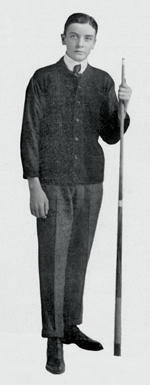|
|
Current Issue
Previous Page Page 2 Next Page
>
Untold Stories: The Boy Wonder
 |
| Well beyond his years, Greenleaf was a fiercely competitive player by his teens. |
NOT MUCH is known about Greenleaf's very early life. Like Willie Mosconi, we know he picked up the game early. Like Mosconi, we know he was the son of a poolroom owner - in this case, the owner of an upstairs room located in Monmouth, Ill. Greenleaf also apparently had two sisters.
The early pictures of Greenleaf reveal a striking young man: slim and handsome with slick-backed hair, a thin nose and a slightly cleft chin. With eyes more doe-like than piercing, Greenleaf might outwardly seem unfit for the hurly burly chaos of the early 20th century public poolroom. But he was certainly a product of the Jazz Age, having been there from the beginning. He competed in his first national championship tournament in 1916, won his first national title three years later, and then embarked on a long and colorful career that included drunkenness, mysterious disappearances - and yes, even a run-in with the cops in a hardboiled murder case.
He was just 16 when he appeared in that first championship, the one in 1916. The venue was Chicago's InterOcean Building. The gathered field included all the warriors of the day, a real wrecking crew of past and present champions. Among them: Jesse L. Chapman, Bennie Allen, John Layton, James Maturo, Emmet Blankenship, Edward Ralph and the dominating Frank Taberski. The tournament ran for a month, beginning Feb. 29.
Although Greenleaf wouldn't win during his first outing in 1916, he nonetheless acquitted himself very well. The gathered talent appeared to flummox the young Greenleaf almost not at all. During a match on March 3, for instance, Greenleaf nervelessly dispatched former champion Maturo - even after having allowed Maturo to creep within four points. "Maturo missed a long try for the eight ball in the right top corner and a favorable kiss left Greenleaf an open ball, from which he picked off the ten (balls) he needed to win," reported the Chicago Tribune's J.G. Davis. A week later Greenleaf similarly demolished Chicago's Chapman. That match included a lighting-fast 40-ball run by the young player, brilliant breaks and terrific long shots.
Greenleaf remained close to the first-place leader throughout the tournament and at one point was even tied for the lead. But he eventually fell to fourth, with Blankenship ending up with the victory. Following in second was Johnny Layton and Frank Taberski in third. But the story wasn't over yet. As a consequence of a series of challenge matches, Greenleaf got another shot at the title in 1916 - this time against Taberski in a three-day challenge match in New York City.
"For once at least a 'boy wonder' has equaled, even surpassed, expectation," gushed The New York Times in reporting Greenleaf's 150-88 victory against the older player on the first night. The two stayed neck and neck on the second night, although Greenleaf remained ahead. It was only on the third night that Taberski overtook him, ultimately beating the young upstart by a combined score of 450 to 407. The Times reported that Greenleaf's "determination and pluck were much in evidence" during the entire competition, and that the youngster "fought to overcome his rival until the very last frame had been played." It also reported that Greenleaf fell victim to his share of unlucky rolls. "This was particularly true in the latter part of the game when he found himself in difficulties on several occasions after having made shots that were startling."
Previous Page Page 2 Next Page
>
Top |
|





